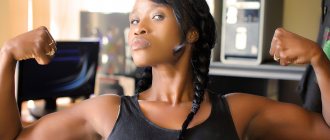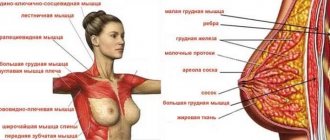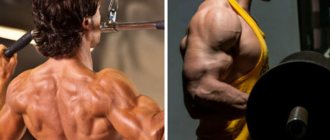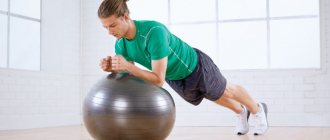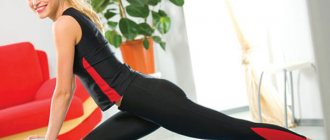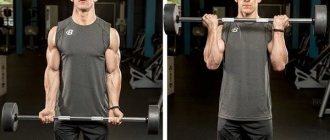© nd3000 — stock.adobe.com
Share:
What you need
- barbell
- dumbbells
- simulators
- horizontal bar
Every man who comes to the gym thinks about powerful arm muscles. And first of all, he pays attention to the development of the biceps flexor muscle - biceps. How to train it correctly and what biceps exercises are the most effective? Read about it in our article.
A little about the anatomy of the biceps
Before considering exercises for pumping up the biceps, let’s refresh our anatomical knowledge. The biceps is a small muscle group that is involved in flexing the arm at the elbow joint. It has a lever structure - this means that the closer the weight is to the hand, the more you need to strain to pump.
Another important feature is that the biceps is not one muscle, but a complex of closely intertwined muscle groups:
- Short head of the biceps. Responsible for the most natural lifting of weights for the body with the hands turned towards the athlete (with supination).
- Long head of biceps. The main muscle head, which gives the biceps mass and strength. The functions are the same. The emphasis on the head depends on the grip width (narrow - long, wide - short).
- Brachialis. Another name is the brachialis muscle, located under the biceps, responsible for lifting weights with a neutral and reverse grip.
Note: The brachialis is not actually a biceps muscle, but it does a great job of adding volume to the arm, sort of pushing out the biceps.
© bilderzwerg — stock.adobe.com
At what rate does biceps grow during normal training?
The growth rate of biceps varies from person to person; it is influenced by many factors: diet, age, intensity and regularity of training, body type, lifestyle and the chosen set of exercises.
In a person of average height and without problems with excess body weight, the increase in the size of the biceps muscle occurs as follows:
- A slight increase in muscle size is observed after 3 months of training, but the first six months are usually spent adapting the body and organism to regular loads.
- After a year, the increase in muscle mass becomes more noticeable; if you follow the basic rules, it can amount to 3 kg.
- After 3 years of active training, the volume of the biceps muscle increases by 5-7 cm.
- After 5 years of training, the growth of muscle mass slows down, the annual increase on average is no more than 5%.
Training principles
To correctly create a complex for biceps, remember the simple principles of its training:
- Despite the almost complete lack of basic exercises for working the biceps flexor muscle, it works great in all back exercises. That is why it is usually done on back day, finishing it off with 2-3 isolation exercises.
- To pump up your biceps, it is enough to use one projectile. But you can alternate, muscles love new exercises and unusual angles of movement.
- The biceps is a small muscle group not designed for intense and long-term work. Therefore, just one arm flexor workout per week with 2-4 exercises is enough.
Home set of exercises with dumbbells
You can increase your biceps by doing only dumbbells, but muscles have the ability to get used to constant load, so growth from the same program will not be very fast. The biceps muscle is pumped depending on many factors, for example:
- genetics;
- proper nutrition;
- discipline;
- patience;
- experience;
- subsequence.
If you have a positive attitude towards success and have free time, you can achieve visible results at home.
Alexander Shestov
TRX Certified Trainer
Ask a Question
In addition to exercises using weights, basic pull-ups on the bar are suitable for pumping up your biceps. You can use a barbell to pump up in the gym.
Exercises
Let's look at the basic exercises for pumping up the biceps.
Basic
The only basic exercise for biceps is the pull-up on the horizontal bar with a narrow reverse grip. Despite the fact that the back is also involved in this movement, you can shift the emphasis to the biceps brachii muscle, without fully extending your elbows and concentrating on lifting by bending your arms.
Various bent over and block rows are also basic, but for the back muscles. The biceps work less here. Therefore, almost all training for this muscle group consists of isolation.
Insulating
Due to the small volume, the easiest way to develop biceps is with a complex of predominantly isolation exercises. They all have similar techniques and differ only in the position of the hand and body. Therefore, we will consider them in groups.
Standing barbell/dumbbell curls
This exercise is considered fairly simple to learn and allows you to gain basic biceps strength. It must be performed in compliance with the amplitude and the number of repetitions of 8-12. There is no need to cheat and swing your body; it is better to take less weight and work strictly according to technique:
- Take the shell. The barbell can be made with a straight or curved bar. The only difference is the convenience for your brushes. The grip is shoulder-width apart or slightly narrower. The dumbbells can be immediately rotated with a grip away from you, or you can rotate the hand from a neutral grip when lifting. If you don't rotate the dumbbell and continue to lift it without supination, you'll end up with a hammer-style exercise. It develops the brachialis and forearm muscles well. Doing both dumbbells at once or alternately is not so important, the main thing is technique.
- Slowly raise the projectile to its peak, without jerking or moving your back. Try not to bring your elbows forward.
- Hold it in this state for 2-3 seconds.
- Lower it down as slowly as possible, without fully extending your elbows.
© Makatserchyk — stock.adobe.com
Extension of the arms at the elbows increases the load when lifting again, shifting it from the muscles to the tendons, which does not allow you to work more intensely and threatens injury when working with heavy weights.
Seated dumbbell raise
A biceps exercise program often includes seated variations of the previous exercise. They are more effective, since even in the initial position the biceps brachii muscle is stretched and under tension. In addition, cheating is eliminated by fixing the case.
The technique is completely identical to the previous version.
© Makatserchyk — stock.adobe.com
Lifting barbells/dumbbells on a Scott bench
If you don't know how to do biceps exercises correctly and don't want to ask an instructor about it, use the Scott bench. The design features of the machine allow you to completely disable not only the back muscles, but also the deltoids, thanks to which you will receive a concentrated biceps workout. It will be difficult to make a mistake with the technique here.
It is preferable to exercise with a W-shaped barbell to reduce the stress on the wrists. If you are doing the exercise with dumbbells, it is better to do it with each hand in turn.
© Makatserchyk — stock.adobe.com
Technique:
- Sit on a bench, press your body against a special pillow, on which you need to place your hands on top.
- Take the apparatus from the racks of the simulator, you can rise a little if you can’t reach them. If you are working out with a partner or trainer, he can hand you a barbell.
- Raise the projectile with a smooth movement.
- Hold it in the peak state for 2-3 seconds.
- Lower it down as slowly as possible, without fully extending your arm at the elbows.
Bent-over biceps curls
There are several options for performing this movement. What they have in common is that the body is inclined to the floor, the arm is hanging (strictly perpendicular to the ground), but the elbow should not move, like the body itself. It turns out to be a very targeted biceps workout, provided the weight is correctly selected.
The most common variations of the movement include bending with a barbell while lying on your stomach on an inclined bench:
© Makatserchyk — stock.adobe.com
Another common option is to bend the arm with a dumbbell at an angle, with the other hand resting on the thigh. Most often it is performed standing, but it can also be done while sitting:
© djile — stock.adobe.com
This also includes concentrated curls with dumbbells. Here the working hand rests on the thigh, but the meaning is the same:
© Makatserchyk — stock.adobe.com
These exercises should be done at the very end of the workout.
Lifting on a block and in simulators
Modern fitness clubs have many different biceps machines. It’s worth trying them all and choosing the one on which you feel the work of the muscle being worked as well as possible. There is no need to put them at the beginning of an arm workout, but they can be used towards the end to “finish off” the biceps. One of the most common options is a machine that imitates a Scott bench:
© Makatserchyk — stock.adobe.com
You can also perform several different variations of bends on the lower block and in the crossover. Using the lower block, you can do lifts with a straight or slightly curved handle, with a rope without supination (analogous to “hammers”), or with one hand:
© antondotsenko — stock.adobe.com
© Jale Ibrak — stock.adobe.com
© Makatserchyk — stock.adobe.com
It is most convenient to work from the upper block in a crossover, while simultaneously bending your arms raised to shoulder level, or bending your arms without supination with a rope (working out the brachialis):
© Makatserchyk — stock.adobe.com
© Makatserchyk — stock.adobe.com
How many exercises for biceps should you do in one workout?
To effectively pump up your biceps with dumbbells, an experienced athlete will need at least three different exercises in one workout. However, when using dumbbells in biceps training, you should avoid using heavy weights. Because excess weight will inevitably disrupt the correct execution technique, which will put an end to the productivity of the entire workout as a whole.
The weight of dumbbells must be selected in such a way that you can perform at least 8-10 repetitions with them in one approach. Using maximum weights designed for only 4-6 repetitions makes sense for experienced athletes who are able to perform all sets of dumbbell biceps curls with perfect form.
In addition to the above reasons, there are several other factors that negatively affect the growth of biceps. After all, many athletes at a certain stage are faced with an annoying problem: muscle growth slows down, despite regular and productive training. This may be caused
- Overtraining the biceps is when it works too often, using too many exercises and approaches in one workout. In this case, the muscles become stronger and stronger, but do not grow;
- The monotony of the training process, when new exercises are not included in the program for a long time, and the old ones are always done in the same order;
- Too long rest breaks between approaches and exercises, irregular exercises;
- Unbalanced and unsuccessful diet, lack of proteins and vitamins in food.
It makes sense to dwell in more detail on the last item on this list. After all, no matter how dedicatedly we train, without good nutrition, muscles do not grow.
How to train?
How many biceps exercises should you do during one workout? The answer to this question depends on the type of activity itself.
If you are focusing on biceps training (if it lags) and want to speed up your results, allocate a separate arm day in the split, and also pump it up additionally on the back day:
- On arm day there is an alternation: biceps exercise - triceps exercise.
- In total, on this day it will be enough to perform 4 exercises: three for the biceps and one for the brachialis. And 3-4 for triceps.
- The first step should always be a reverse grip pull-up, standing barbell curl or seated dumbbell curl.
- The second is another exercise from the same list or bending on a Scott bench.
- Third, it is best to place one of the lifts in an incline or on a block.
- After a back day, it is enough to do two pump-style exercises for 15-20 repetitions in 3 sets.
If we consider the general program for massing/cutting within the framework of a split, it is reasonable to combine the biceps with the back. Then two, maximum three exercises are enough.
How to pump up biceps correctly and quickly
Both men and women need to perform the same number of repetitions to gain mass, but the weight will be different.
To gain mass, perform 8 to 12 repetitions in one approach. The weight is selected so that it is impossible to perform more repetitions
It makes no sense to train your arms more than twice a week, even though the muscle recovers in 1-2 days, do not forget to pay attention to other muscles.
For a speedy recovery, after training it is recommended to stretch the loaded muscles well. To do this, stretch your hand in front of you with your palm up, grab it with your other hand and press down on your wrist so that you feel the biceps stretch. The fibers will return to their normal state, they will not be stiff and inelastic
It is important to do a warm-up first for muscle growth. Warm muscles are less susceptible to injuries and sprains
Correct technique is 80% of the success of a productive workout
It doesn’t matter what weight you work with, if the biceps curl is performed by additional muscles, with the help of body sway and inertia. Exercises for the biceps are performed isolated and concentrated, which means that other muscles do not need to be involved
Exercises for biceps are performed isolated and concentrated, which means that other muscles should not be involved.
To begin with, you can perform the arm curl technique while sitting or standing against a wall, so the body will be fixed and will not be able to swing. The movement of shoulder flexion should be faster, and relaxation and extension should be slower. The negative phase is of great importance for mass growth; in this phase, tension is maintained, in contrast to simple extension, which was not accompanied by effort, but only by a fall. Perform all exercises efficiently, training with both dumbbells and a barbell. Rest between sets for no more than two minutes.
“Basic standing barbell curls allow you to pump your biceps with heavy weights.”Effective training program
To effectively work the biceps flexor muscle, use classic programs^
| Program | How often | Incoming exercises |
| Arm day with emphasis on biceps | Once a week + 1-2 more pump-style biceps exercises after back | Standing barbell curls 4x10 Close grip press 4x10 Curls with a barbell on a Scott bench 3x12 French bench press 3x12 Raises on the lower block with a straight handle 3x12-15 Overhead arm extensions with rope on a 3x12 block Raising dumbbells on an incline bench with a neutral grip 4x10-12 Arm extensions with rope on the upper block 3x15 |
| Split back + biceps | No more than once a week, evenly distributed with other training days | Wide grip pull-ups 4x10-12 Deadlift 4x10 Bent-over row 3x10 Wide-grip lat pull-down to chest 3x10 Standing biceps curl 4x10-12 Lifting dumbbells while sitting on an incline bench 4x10 |
| Home | Two times a week | Reverse grip pull-ups 4x12-15 Lifting dumbbells for biceps while standing, alternately 3*10-12 Concentrated dumbbell lift while sitting 3*10-12 Hammers with dumbbells standing 4x12 |
Arm curl while sitting on an incline bench
The exercise will force you to strictly approach the execution, since the pressed back will prevent you from swaying. This exercise stretches the biceps to the maximum. This exercise works the biceps muscle from all sides. In addition to the biceps, the brachialis, brachioradialis and pronator teres muscles work. The exercise is quite difficult, and you need to approach it seriously with help.
For beginners: optimally, do 2-3 sets of 8-10 repetitions with 5-8 kg. This way you can evaluate your preparation and increase weight depending on your success.
- Sit on an incline bench, pressing your feet firmly to the floor. Press your shoulders against the bench. Don't arch your back.
- Hands with dumbbells along the body with arms down, palms facing each other. Press your elbows to your sides.
- When lifting, work your biceps into flexion. Turn your palms up while lifting. Rotate the hand, the wrist tends upward as much as possible.
- Don't lift your back off the bench. Watch your elbows.
- Do not spread your arms out to the sides; they should be parallel to your body.
- If you spread your arms while lifting, the load will shift to the inside of your biceps.
- Make sure you are breathing correctly. Thanks to him, shortness of breath will not bother you. At the moment of bending, exhale, at the moment of lowering the dumbbells, inhale.
- To stretch your biceps more, press your head against the bench.
- The exercise is quite difficult, and the weight of the dumbbells should be 70-80% of those you use while standing.
- Do not tilt the bench relative to the floor below 50 degrees. This will give your biceps a super stretch. Trauma under such conditions increases with progression!
Technique for performing arm curls while sitting on an incline bench
Standing dumbbell curls for pumped up biceps
And again the rise! We're not done yet, but we're almost there. To effectively tone your biceps with these dumbbell curls, start the first set with the heaviest weight you can lift and then work your way down to failure. So you start with a heavy weight and end with a light weight. The goal of this approach is to completely overload the biceps to ensure that they are truly tired and to give them the impetus for intense work.
Using a reverse grip, grab dumbbells with the maximum weight you can lift, palms facing forward. Curl the dumbbell while keeping your elbows stationary and close to your body. Do three repetitions with the maximum weight, then decrease the weight until you are unable to do at least one more repetition.
Your weight loss should look something like this:
- 1 x 3 reps
- 1 x 5 reps
- 1 x 7 reps
- 1 x 10 reps
- 1 x 10 reps
- 1 x 15 reps
- 1 x 20 reps
What factors cause muscle growth?
Before moving on to the exercises, let's look at the main factors of muscle growth. This is necessary for a clear understanding of the appropriateness of the exercises that we will consider below.
To simplify it as much as possible, muscle development requires building material (amino acids), energy (glucose), hormones (the body synthesizes them in response to training stress) and muscle tension or tension, which initiates growth. Moreover, sufficient muscle tension is the main factor , without which there will be no progress, even if the accompanying conditions are met.
Accordingly, for effective development of muscles, including biceps, it is necessary to create conditions in which there is noticeable muscle tension without unnecessary stress on the ligaments and tendons. This is achieved by using the correct technique for performing the exercise and understanding its biomechanics.
We recommend reading: What spoils your posture
In the case of the biceps brachii muscle, for example, the grip width of the barbell during a classic biceps curl does not matter. Let me remind you that with any bending of the arm, both heads of the biceps are always tense. Thus, the grip should be comfortable to maximize muscle tension with minimal stress on the hands and elbows.
This is much more effective than trying to pump up the outer and inner heads of the biceps separately by varying the grip width. You will spend more time, and due to a grip that is too wide or too narrow, you will overstrain your joints and ligaments, which will not allow you to create sufficient muscle tension. Progress in increasing the weight, and therefore adapting the muscle to the load through its growth, will stop before the size of the biceps begins to please you.
III Superset
Dumbbell press on a fitball and Dumbbell row with support on a fitball
15 reps + 10 reps
Technique for performing dumbbell presses on a fitball:
This exercise targets your pectoral muscles, as well as your triceps and shoulders, which are a must-work.
Lie with your back on the fitball, hang your head and neck. Hold the dumbbells slightly above your chest with your elbows touching the ball. Straighten your arms with dumbbells above your chest. Flex your arm muscles, then slowly lower yourself to the starting position.
Technique for performing bent-over dumbbell rows supported by a fitball:
This row variation is great for isolating one side of the body at a time, so you can focus on contracting your back muscles in more detail.
You're only using one of your dumbbells for this exercise, so set the other side aside.
Stand and lean forward, holding a dumbbell in one hand and touching the ball with the other hand.
Keep your knees slightly bent.
Make sure your spine and neck form one straight line.
Bring the dumbbell toward your chest, flexing your back at the top of the movement, and then slowly lower it until your arm is completely straight.
Repeat, focusing on your back muscles, and exhale each time you lift the weight up. After 10 repetitions, take the dumbbell in your other hand and repeat on the other side.

